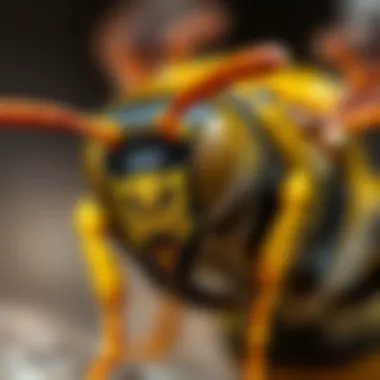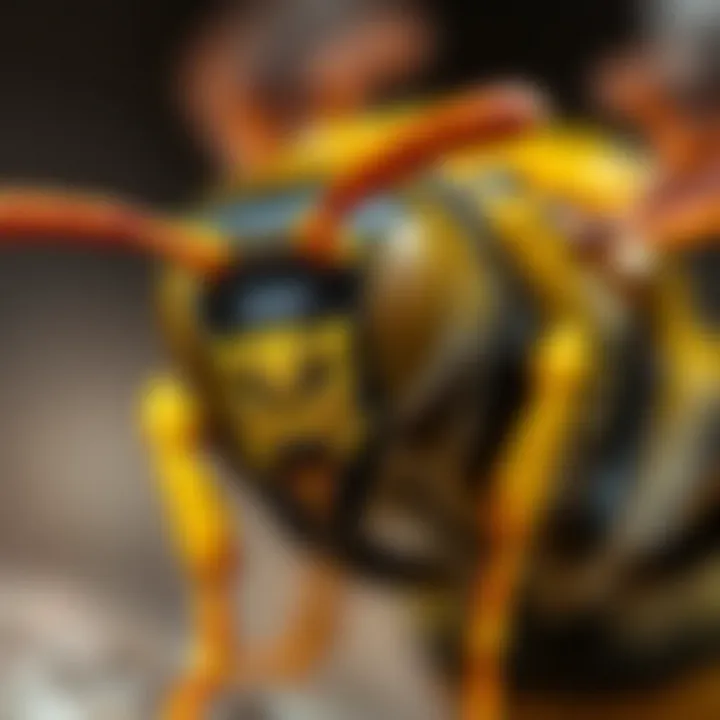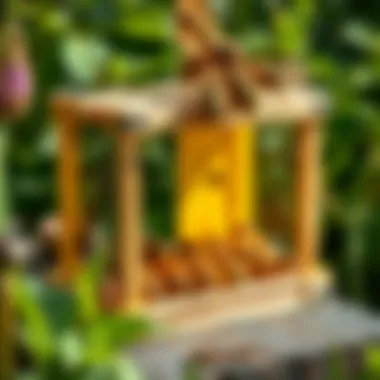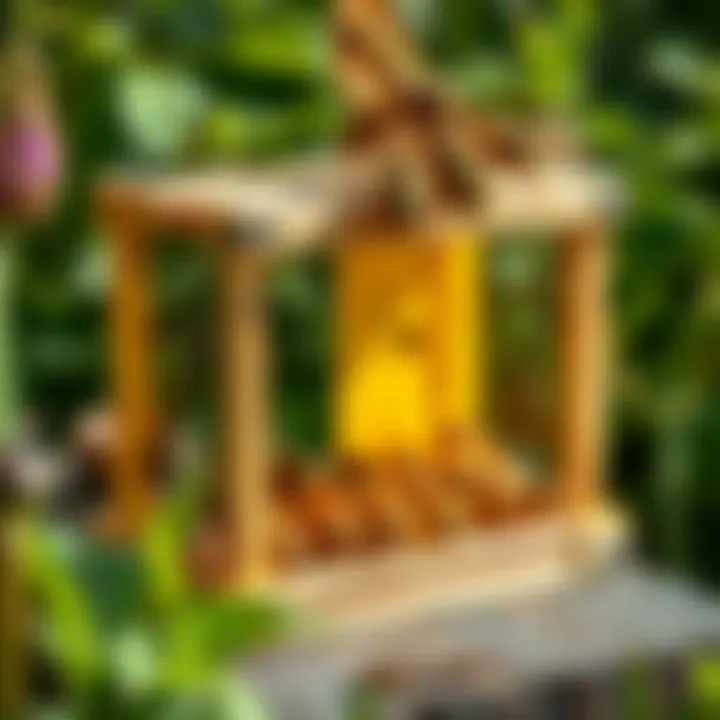Understanding Yellow Jacket Wasp and Hornet Traps


Intro
Managing yellow jackets and hornets can feel like tackling a particularly tricky puzzle. When these creatures invade our spaces, they can swiftly turn a pleasant barbecue into a scene of panic. Understanding how to deal with these pests involves more than simply identifying a few insects. It's essential to approach the subject comprehensively to stay a step ahead of them.
In this guide, we'll explore several crucial areas concerning these wasps and hornets. We’ll kick things off with Pest Identification, where we clarify the common types that homeowners might encounter. We will delve further into Prevention Strategies, highlighting practical tips to keep these pests at bay. Finally, we’ll touch on Treatment Options to help you understand various methods whether you prefer DIY solutions or professional help.
With the right knowledge in hand, you’ll feel more empowered against these yellow jackets and hornets, making your living space safer and more enjoyable. Let's start by identifying who we're up against.
Understanding Yellow Jackets and Hornets
When it comes to outdoor living, yellow jackets and hornets often join the scene uninvited. These insects might be small, but their presence can turn a sunny picnic into a worrying situation. Grasping their habits and traits is essential. Knowledge about yellow jackets and hornets not only helps you dodge their painful stings but also guides you in creating effective traps. This section will break down their biological classification, physical characteristics, and behavioral patterns, providing a solid foundation as we dive into strategies for trapping and management.
Biological Classification
Yellow jackets and hornets are members of the family Vespidae, which also encompasses many other wasps and hornets. More specifically:
- Yellow Jackets belong primarily to the genus Vespula, with species like Vespula germanica and Vespula pensylvanica being the most common pests in various regions.
- Hornets, on the other hand, often belong to the genus Vespa, with the bald-faced hornet (Dolichovespula maculata) as a prime example.
Interesting enough, yellow jackets are social insects, which means they live in colonies. Their nests can be found in various habitats, from underground burrows to attics. Hornets can also be social, and their nests resemble paper mache made from wood fibers. This distinction plays an important role in understanding how to tackle them effectively, as their behavior can change depending on their environment and species.
Physical Characteristics
Both yellow jackets and hornets come with distinct visual cues that can aid in their identification. Here’s a rundown:
- Yellow Jackets: They are characterized by their slender, bright yellow bodies interspersed with black markings. They measure around 1/2 to 5/8 of an inch in length. What sets them apart is their narrow waist, which makes them look more wasp-like compared to bees.
- Hornets: These insects tend to be larger, averaging about 3/4 to 1 inch in length. Their bodies are typically more robust and can be predominantly black with yellow or white markings. The bald-faced hornet, in particular, is noted for its striking black and white patterns.
Understanding these physical traits not only helps in identification but also aids in knowing which traps to set and when to be cautious.
Behavioral Patterns
Behaviorally, yellow jackets and hornets exhibit unique habits that heavily influence how they interact with their environment and humans.
- Feeding Habits: Yellow jackets are notorious scavengers. They often steal food from picnics or garbage, drawn by sugary and protein-rich substances. Hornets, while also attracted to sugary substances, prefer to hunt other insects for protein. Understanding this can help in choosing the right bait when trapping.
- Aggressiveness: In general, yellow jackets are more aggressive, particularly late in their season when food becomes scarce. They can become quite fearless, swooping in to protect their nesting areas. Hornets are less aggressive unless provoked but can deliver painful stings if their nests are threatened.
Grasping these patterns allows homeowners to prepare for encounters effectively. It can also inform the optimal timing for setting traps, particularly while food is plentiful or when nests are disturbed.
Understanding the basics about yellow jackets and hornets serves as an essential first step in effective pest management. Armed with this information, you're not only ready to deploy traps but also minimize risks associated with these pesky insects.
The Importance of Trapping
Understanding why trapping yellow jackets and hornets is necessary goes beyond just personal discomfort; it's about safeguarding our health and maintaining a pleasant environment. These wasps and hornets are not only nuisances but also potential threats, particularly in areas where families gather or where outdoor activities are prevalent. By employing effective trapping methods, homeowners can significantly reduce the presence of these stinging insects, ensuring a safer outdoor experience.
Health Risks Associated with Stings
Yellow jackets and hornets can pose serious health risks, especially to individuals allergic to their venom. A single sting can result in a range of reactions, from mild irritation and swelling to more severe symptoms like anaphylaxis, which is life-threatening. The American Academy of Allergy, Asthma & Immunology estimates that about 2 million people in the United States are at risk of a severe allergic reaction from stings. It’s not just about avoiding pain; for some, a sting can bring about a hospital visit.
Moreover, stings often occur unexpectedly, especially when these insects are defending their nests or foraging for food. A moment’s distraction can lead to painful encounters, particularly if children or pets inadvertently provoke them. Homeowners must take these risks seriously, not only to safeguard their well-being but also to protect guests and loved ones who may be vulnerable to more severe reactions.
Impact on Outdoor Activities
The presence of yellow jackets and hornets can put a damper on outdoor gatherings. Imagine hosting a summer barbecue or a family picnic, only to have your guests swatting away aggressive wasps. These insects are attracted to sugary foods, meat, and even those delightful desserts we often bring out at gatherings.
Trapping helps to create a more enjoyable atmosphere by decreasing the likelihood of stings and their annoying presence. When traps are effectively used, they can lure the pests away from picnic areas and outdoor spaces, allowing families to enjoy their time together without fear or frustration. Here are some key impacts:
- Reduced anxiety: Knowing that traps are set can boost confidence in spending time outdoors.
- Increased satisfaction: A wasp-free environment leads to a more pleasant gathering, encouraging people to relax and fully engage in activities.
- Protection of food supplies: Properly placed traps can divert insects from food areas, making it easier to enjoy meals without uninvited guests.
In summary, understanding and acknowledging the importance of trapping yellow jackets and hornets can not only improve the quality of outdoor experiences but also ensure a safer environment for everyone involved. Implementing strategic trapping methods is crucial in managing these pests effectively.
Types of Yellow Jacket and Hornet Traps
Understanding the different types of yellow jacket and hornet traps is crucial for effective pest management. There’s no one-size-fits-all solution, and choosing the right trap can significantly impact how well you manage these nuisances.
Utilizing traps allows homeowners to reduce the population of these pests, especially in areas where they can pose a health risk or disrupt outdoor activities. Moreover, recognizing the benefits of various traps can help tailor strategies that suit your specific situation.
Commercially Available Traps
Commercial traps can be a great solution for homeowners looking for quick and effective ways to manage yellow jackets and hornets. These traps are often designed with special features that lure pests effectively, such as built-in baits and specialized entrances that prevent escape once inside.


A notable advantage of commercially available traps is their ease of use. Many come pre-assembled or require minimal setup, making them convenient for anyone who may not have the time or know-how to construct a homemade trap. However, the downside can often be their cost, as some high-end options may take a bite out of your wallet.
Homemade Traps: Materials and Methods
Creating homemade traps offers flexibility and creativity. One can whip up something simple out of materials found around the house, reducing costs while allowing for experimentation. Here we explore a few popular homemade methods:
Plastic Bottles
Using plastic bottles as traps is a common and effective method. The key characteristic of plastic bottles is their availability; most households have a few empty ones lying around. Simply cutting the bottle and inverting the top section can create a funnel effect that entices the yellow jackets into the trap.
One unique feature here is the ease of modification. You can add baits and adjust the entrance size based on the size of the yellow jackets in your area. However, ensure that the trap is kept clean and monitored regularly to maintain its efficacy, as neglected traps can become less effective over time.
Jar Traps
Jar traps are another efficient homemade option. These traps can use mason jars or any other similar container. The standout feature of jar traps is that they can be closed tightly after trapping, reducing the chance of escape. One can also layer different baits within the jar to attract more pests.
However, the downside is that checking these traps frequently is essential. If left for too long, captured wasps can die and decompose, possibly leading to further pest attractants or unpleasant odors around the area.
Sugar Water Solutions
Sugar water solutions are an enticing bait for many pests, including yellow jackets. This method’s main appeal lies in its simplicity—mixing sugar with water provides a sweet taste that attracts these insects. The solution can be used in conjunction with other trap methods.
Its unique feature is the versatility with different ratios; you can experiment with different amounts of sugar to see what works best for your area. On the downside, it’s less effective in cooler temperatures, as sugar water may not attract as many wasps, making it more suitable for warm-weather trapping.
Bait Options for Increased Effectiveness
Selecting the right bait is just as important as the trap itself. Here are some options to consider:
Protein-based Baits
Protein-based baits, such as tuna oil or scraps from meat, can be particularly effective. They appeal to yellow jackets that are on the hunt for protein to take back to their nests, especially in late summer and early fall when larvae need feeding. These baits provide a great way to increase the effectiveness of any trap.
The key characteristic here is that they might draw in other non-target pests, making monitoring necessary. Customizing your bait can be rewarding, although you might need to experiment with various foods to find what works best.
Sugar-based Baits
On the sweeter side, sugar-based baits and syrups often lure in wasps looking for a quick sugar boost. The beneficial aspect of these baits lies in their simplicity and ease of use. Sweets are universally appealing to yellow jackets and can be mixed in with other trap materials seamlessly.
However, sugar-based baits can also attract bees and other beneficial insects, making it necessary to monitor which species are drawn to your trap. Balancing bait is key to ensuring that beneficial insects are kept safe while targeting unwanted pests.
Trapping yellow jackets and hornets effectively requires a blend of the right tools and strategies. Each method of trapping offers unique advantages and challenges, but understanding how to best leverage these features can greatly increase your success in managing these pests.
Setting Up Traps Effectively
Setting up traps effectively is not just a matter of throwing them out haphazardly and hoping for the best. It’s a strategic approach that can significantly enhance the efficiency of your trapping endeavors. When done right, this practice helps eliminate bothersome yellow jackets and hornets while ensuring minimal risk to you and your family. Recognizing the right locations, timing, and bait can mean the difference between catching just a few pests and swarming them out.
Optimal Locations for Placement
Near Nesting Sites
Placing traps near nesting sites presents a goldmine of opportunity. Yellow jackets and hornets are territorial creatures, and their nests often become hotspots for activity. This proximity plays a crucial role in maximizing your capture rates. By positioning traps close to nests, you've got a high likelihood of intercepting foraging wasps that are in search of food to bring back to their colony.
A unique feature of this tactic is that these nests can often be found in shaded areas around homes, making them prime targets for placement. However, it’s essential to approach them with caution as these locations may also pose a risk to your safety, especially if the insects feel threatened. Take heed of your surroundings and consider the challenges before setting your traps too close.
Proximity to Human Activity
On the other hand, proximity to human activity offers another effective placement strategy. Yellow jackets are notorious for invading backyard barbecues, picnics, and outdoor events. By placing traps a stone's throw from these areas, you can lure in the pests that are drawn to food sources or sweet drinks.
The key characteristic of this approach is that it creates a buffer zone, providing an immediate barrier between your guests and the imminent threat. While this strategy is popular, the downside lies in the fact it could attract wasps from nearby nests, potentially increasing your risk of stings. Choosing the right distance and ensuring the area is safe can mitigate these threats.
Timing: When to Set Traps
Seasonal Considerations
The timing factor cannot be overstated. Seasonal considerations are paramount in determining when to set your traps. Yellow jackets and hornets are more active in late summer and early fall. This period marks the height of their foraging activity, as colonies are at their largest and most voracious. Deploying traps during this time can yield the best results, capturing a substantial number of these pests before they can cause any more trouble.
Acting too early in the spring can lead to wasted effort, as these insects are either still establishing their nests or fewer in numbers. A unique feature of taking seasonal factors into account is your ability to tailor your strategy based on the life cycle of these insects. Keeping your traps ready for action as the temperature rises can significantly improve effectiveness.
Time of Day Factors


Equally important is the consideration of time of day. Setting traps during the daylight hours is essential, as this is when yellow jackets and hornets are most active. Their foraging behavior peaks during warm afternoons when they’re on the hunt for food. Positioning traps at strategic intervals throughout the day, particularly in the early afternoon, is a sound move. A key characteristic of this approach is the light and warmth that attract these insects to your traps, increasing the chances of catching them.
However, it is worth noting that placing traps too late in the evening or at dawn may not yield the desired results. During these cooler times, the wasps' activity reduces significantly, leaving your traps empty. Therefore, aligning your trapping efforts with the active periods of these pests makes all the difference in your results.
Effective trapping requires not just the right tools but savvy planning and an understanding of insect behavior. Concisely determining when and where to set your traps can save you both time and frustration.
By focusing on the optimal locations and timing, you can ensure you're well-prepared to handle these buzzing nuisances, making your outdoor spaces more enjoyable.
Maintaining Traps for Continued Efficacy
Trapping yellow jackets and hornets isn’t just a matter of setting up a trap and forgetting about it. To truly manage these pests effectively, maintaining the traps is paramount. Without proper upkeep, even the best traps will fall short in their mission. By regularly attending to traps, you ensure that they remain effective, thereby safeguarding your outdoor spaces from uninvited winged guests.
Regular Cleaning and Monitoring
Keeping traps clean is essential. Over time, traps accumulate debris, dead insects, and residue from the bait. If not addressed, this build-up can deter other yellow jackets and hornets from entering or using the trap. The buildup can also lead to poor attraction overall, making it less effective.
Here’s a simple regimen you can adopt for maintaining your traps:
- Frequency: Check traps at least once a week, especially during peak season when wasps are most active.
- Cleaning Process: Wear gloves to avoid any contact with insect remnants. Use warm, soapy water to clean the inside of the trap, ensuring you remove any sticky residue.
- Inspection: During each cleaning, inspect the trap for any signs of damage. Look for holes or cracks that might allow yellow jackets to escape or avoid the trap altogether.
- Monitoring Captures: Note the number of insects caught to gauge how effective the trap is. If you’re seeing fewer captures over time, it might be time to rethink your bait or trap placement.
Keeping your traps clean could mean the difference between catching a hundred wasps or just a few. It’s the little things that often lead to big results.
Replacing Bait and Traps
Even the most potent bait loses its allure over time. For a persistent and effective trapping operation, you’ll need to replace bait periodically. Here’s how to manage bait replacements:
- Type of Baits: If you’re using protein-based baits, more frequent change might be necessary compared to sugar-based options, as protein tends to spoil faster.
- Observation: If you notice the bait has changed color or consistency, it’s time to swap it out. Also, if your trap isn’t capturing insects as anticipated, reassess the bait used.
- Trap Replacement: Depending on the materials, traps can degrade with exposure to the elements. Check for wear and tear, and replace traps if they seem compromised. Many plastic traps only last a season before needing a replacement.
When replacing, consider using a different bait formula if your traps have plateaued in capturing wasps. This kind of variation can sometimes rekindle interest. And always keep a few extra traps on hand, as having replacements ready means you won’t lose any steam in your pest management efforts.
Maintaining traps might initially feel like a hassle. However, with effective routines in place, it turns into an easier task. The payoff of having clean, effective traps far outweighs the minimal effort required to keep them running smoothly. By staying vigilant on cleaning and maintaining bait, you enhance your chances of successfully managing yellow jackets and hornets in your space.
Safety Considerations During Trapping
When it comes to dealing with yellow jackets and hornets, prioritizing safety during trapping is not just a good idea—it’s essential. These insects are known for their painful stings and, in some cases, serious allergic reactions. Thus, understanding safety practices is crucial for anyone considering trapping these pests. By taking the right precautions, individuals can mitigate the risks associated with wasp and hornet encounters, allowing for a more educated and steady approach.
Protective Equipment to Wear
Before embarking on a trapping venture, it’s wise to gear up properly. The kind of protective equipment one chooses can significantly influence the overall safety of the process. Here’s a breakdown of what you might consider:
- Long-sleeved shirts and pants: Opting for tightly woven fabric can be your first line of defense. Fabrics that are not easily penetrable can serve as a barrier against potential stings.
- Gloves: Wear sturdy gloves, particularly those that cover the wrists well. These can protect your hands from accidental stings.
- Face veil or netting: If you are particularly vulnerable or have had issues with stings before, consider wearing a face shield or netting. This provides protection for the face and neck where stings can be particularly painful.
- Sturdy footwear: Closed-toe shoes or boots can safeguard your feet. Think about materials that aren’t easily surpassed, giving you an added layer of defense.
Feeling safe while tackling pests goes a long way; not only does it reduce the chance of getting stung but also makes the task less daunting.
Emergency Response to Stings
Even with all the right precautions, stings can still happen. Understanding how to respond to them is vital. Here’s how one can prepare:
Identifying Allergic Reactions
Recognizing an allergic reaction to insect stings can be a game-changer in crisis management. One key characteristic of an allergic reaction is swelling that extends beyond the sting site. Redness and itching are common, but if a person experiences symptoms like hives, difficulty breathing, or dizziness, these are red flags.
What makes identifying these reactions so crucial is the potential severity. Some individuals may go into anaphylactic shock, which can become life-threatening without timely intervention. Knowing the signs quickly could save a life. The unique feature of being alert to this can empower individuals to act swiftly, seeking medical attention when necessary.
Preparing First Aid Kits
Having a first aid kit at the ready during trapping expeditions is a simple yet effective way to ensure you are prepared. A well-stocked first aid kit might include:
- Antihistamines for allergic reactions
- Sterile gauze and adhesive bandages for covering stings
- Ice packs to reduce swelling
- A small first aid manual that outlines basic responses to insect stings
The primary characteristic of a prepared first aid kit is its versatility; it addresses various minor injuries beyond just insect stings. Having such a kit is not only beneficial but provides peace of mind. The unique advantage lies in its readiness to tackle unforeseen incidents, creating an environment where pest control feels manageable.
In summary, prioritizing safety during trapping isn't merely a suggestion; it's a necessity. By understanding how to use protective equipment and how to respond in the event of stings, the task at hand becomes less of a gamble and more of a calculated effort. Safety, after all, is the name of the game.
Preventing Yellow Jackets and Hornets
Taking proactive steps to prevent yellow jackets and hornets from invading your living space is crucial for maintaining a peaceful environment. These pests can be quite the nuisance, making outdoor activities troublesome and posing potential health risks through their stings. Prevention not only saves you the headache of dealing with pest control later on but also creates a more enjoyable outdoor experience for you and your family.


Eliminating Attractants Around Your Property
One of the most effective measures in keeping yellow jackets and hornets at bay is by eliminating food sources that attract them. These insects are opportunistic feeders and are drawn to sweet sugary substances and protein-rich foods.
Here are some practical tips:
- Secure Trash Bins: Make sure that trash cans are tightly sealed with lids. Leftover food and sugary drinks can attract these pests from afar. Consider using bins with a locking mechanism if you live in areas heavily populated with hornets and yellow jackets.
- Clean Up Spills Immediately: If you've had a picnic or a barbecue, don't delay in cleaning up food waste and spills. Even small crumbs or a splash of soda can become a buffet for these insects.
- Avoid Outdoor Eating: When possible, try to eat indoors. If you must eat outside, do so in a confined area and ensure to clean up promptly.
- Garden Care: If you have a garden, remove any overripe fruit and keep fallen vegetables cleared. Compost bins should also be tightly sealed to deter visitation.
By removing potential food sources, you are effectively making your home less appealing to yellow jackets and hornets.
Sealing Entries and Nesting Areas
In addition to eliminating food attractants, it's equally important to seal off potential nesting sites. Hornets and yellow jackets are industrious builders, and they often search for places that offer protection and some shelter.
Here's how to fortify your home against these intruders:
- Inspect Your Home: Regularly check for cracks and crevices in your foundation and walls. If you find any gaps larger than a quarter-inch, fill them with caulk or foam insulation.
- Ventilation Screens: Install fine mesh screens on vents, chimneys, and windows. This will help prevent these insects from accessing spaces they might consider as potential nesting sites.
- Trim Vegetation: Keep bushes and shrubs well-trimmed. Dense vegetation can provide a perfect cover for nests. If you spot nests, avoid removing them yourself; it’s best to call a professional.
- Store Outdoor Items Properly: Items like garden furniture, tools, and children’s toys should not be left out. Store them in a shed or garage to minimize nesting opportunities.
By ensuring that there are no inviting spaces for these invasive creatures, you can keep them from making themselves at home.
Prevention is key—an ounce of prevention is worth a pound of cure.
In short, by adopting these strategies, you will create an environment that discourages yellow jackets and hornets, significantly reducing the chances of an infestation. It not only enhances your comfort outdoors but also fosters a safer living space for your family.
Evaluating Trap Effectiveness
When it comes to managing yellow jacket wasps and hornets, knowing whether your trap is doing its job is essential. Evaluating trap effectiveness highlights not only how well your traps are working but also guides future decisions about pest control. Poorly functioning traps can mean more buzz in your life and less relief, which is precisely what we want to avoid.
Regular assessments of trap performance can help determine if the location and bait are appropriate. If you find that traps are not capturing as many insects as expected, it might be time to tweak your setup. Analyzing what's happening in your yard can also save you from further infestations and unnecessary headaches down the line.
Tracking Captured Insects
An integral part of evaluating the effectiveness of your traps is keeping track of the insects caught over time. This is not just about counting; it's about establishing trends and patterns. Maybe one type of bait is catching more than another, or perhaps the traps near the trash cans are snagging more wasps. Documenting these details can help you fine-tune your strategy.
Here are some key points to note:
- Type and Number: Write down what types of insects you've caught and in what quantity. This helps in identifying which traps are performing best.
- Time of Day: Notice if more wasps are caught during specific times. This might influence when you set or check your traps.
- Environmental Changes: Be aware of any seasonal shifts or nearby construction that could be impacting your results.
By keeping a simple log, perhaps even on your phone or a notepad, you can more clearly see the effectiveness of your traps and adjust accordingly.
Adjusting Strategies Based on Observations
Once you've tracked captured insects, the next step is to adjust your strategies accordingly. Think of it as a chess game. Just as chess players strategically move their pieces based on their opponent's actions, your pest control tactics should evolve from your observations. If a certain bait isn't working, don't hesitate to change it or try a different trap method.
Here's how to pivot effectively:
- Switch Up the Bait: If sugary solutions are falling flat, consider introducing protein-based baits, which appeal to these pests differently. The key is variety and adaptability.
- Change Trap Locations: Maybe your current placement isn't hitting the mark. Shift traps nearer to where you've seen activity or away from areas that don’t attract as many wasps.
- Monitor Seasonal Behavior: Wasps and hornets behave differently as the seasons change. Understanding their cycle can help you craft a more proactive strategy.
Make adjustments not based on guesswork but on solid evidence gathered from your own yard. This hands-on approach ensures your pest management tactics are tailored to your specific situation, and ultimately, more successful.
"Being a step ahead in pest management can save you the buzz and drama. Be observant, be adaptive!"
By focusing on evaluating trap effectiveness, homeowners can maintain control over their outdoor spaces. Strengthening your pest management is all about observation, documentation, and adaptation. Armed with this knowledge, you can truly create a safer, more enjoyable environment.
Ending: The Role of Trapping in Pest Management
Trapping is not merely a coincidence of pest control; it stands as a crucial component in the overall strategy of managing yellow jackets and hornets. Understanding the subtleties of trapping contributes immensely to reducing the irritations these insects might bring. Besides providing immediate relief through population control, trapping fosters safe outdoor environments, particularly for those who enjoy spending time in their backyards.
Adopting effective trap setups helps mitigate health risks linked to stings, ensuring that families can engage in picnics, barbecues, and other outdoor activities without fear. Furthermore, knowledge of trapping allows homeowners to be proactive rather than reactive. By integrating traps into the natural management routine, homeowners not only eliminate immediate threats but also prevent future infestations by disrupting reproductive cycles. Thus, trapping serves dual purposes: protecting individual well-being and contributing toward a broader ecological balance.
"A stitch in time saves nine." Timely trapping efforts provide a fantastic leap forward in controlling pest populations before they spiral out of hand.
Summary of Best Practices
To effectively manage yellow jackets and hornets, implementing best practices in trapping should be foremost in every homeowner’s mind. Here are several key recommendations:
- Choose the Right Trap: Different traps work best in various settings. Research your options—commercial or homemade—based on your specific circumstances.
- Placement is Key: Position traps in areas where these insects are frequently spotted or around food sources. Proximity to nests also increases efficacy.
- Regular Monitoring: Traps won’t do the job if they aren't checked regularly. Assessing their contents allows you to stay one step ahead in controlling population sizes.
- Cleaning and Maintenance: Dirty traps might deter the insects or fail to attract them. Regular cleaning ensures traps remain effective over time.
Adhering to these practices will not only manage existing problems but also minimize the risk of future infestations.
Final Thoughts on Preventive Measures
While trapping can significantly reduce the nuisance posed by yellow jackets and hornets, prevention is always better than cure. Here's how to bolster your yard's defenses:
- Seal Food Sources: Ensure that outdoor garbage bins are sealed, compost piles are managed carefully, and pet food isn’t left outside. These measures discourage wasp attraction.
- Limit Nesting Opportunities: Regularly check for potential nesting sites around your property and seal gaps in structures. Pay attention to unkempt areas that could serve as attractive nesting grounds.
- Plant Selection Matters: Certain plants can attract or repel yellow jackets and hornets. Research which options best suit your landscaping needs while considering their influence on local pest populations.



